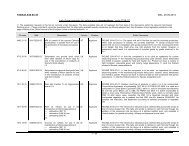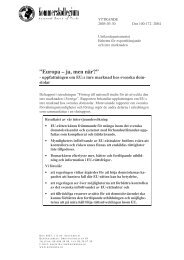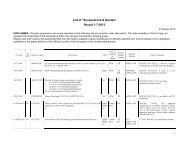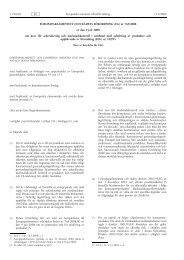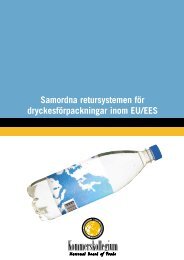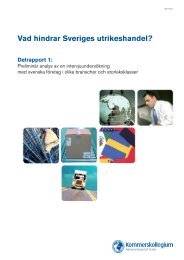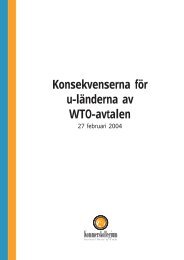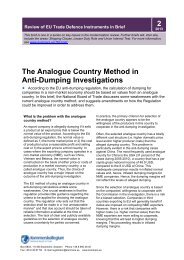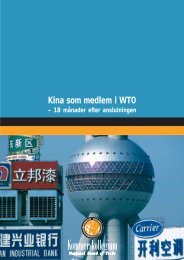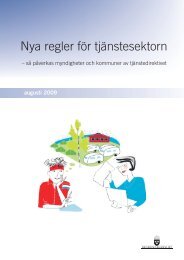Trade Facilitation - Impact and Potential Gains - Kommerskollegium
Trade Facilitation - Impact and Potential Gains - Kommerskollegium
Trade Facilitation - Impact and Potential Gains - Kommerskollegium
- No tags were found...
You also want an ePaper? Increase the reach of your titles
YUMPU automatically turns print PDFs into web optimized ePapers that Google loves.
<strong>Trade</strong> facilitation is a comprehensive <strong>and</strong> integrated approach to reduce thecomplexity <strong>and</strong> cost of the trade transaction processes. It aims at ensuring that alltrade activities can take place in an efficient, transparent, <strong>and</strong> predictable manner,based on internationally accepted norms, st<strong>and</strong>ards <strong>and</strong> best practices. At thesame time, it seeks to optimise the effectiveness of regulatory controls to ensurethe safety <strong>and</strong> well-being of citizens <strong>and</strong> the collection of appropriate taxes <strong>and</strong>fees. 10The exact benefit of a trade facilitation measure differs from country to country,from company to company <strong>and</strong> from product to product. However, as severalinternational studies prove, the overall positive gains of trade facilitation arebeyond doubt.3.1 Previous Work <strong>and</strong> International ExperiencesAs a consequence of the methodological difficulties in making larger explicit costbenefitstudies, few have been done. The major <strong>and</strong> most widely accepted studies<strong>and</strong> estimates are presented below. It is however very problematic to crosscomparethem. They do not use the exact same definition of trade facilitation, norsimilar areas (geography wise or commodity wise) or methodological boundaries<strong>and</strong> they estimate the costs at very different periods of time. This presentationwill thus not be used to cross-compare the various previous studies, but simplyhighlight their results <strong>and</strong> show the magnitude of the possible gains resultingfrom trade facilitation.US National Committee on International <strong>Trade</strong> Documentation (US NCITD) didthe first <strong>and</strong> largest study in 1971. 11 It is a very comprehensive report <strong>and</strong> assertsfrom the factual data collected <strong>and</strong> developed in the study, that costlydocumentation is one of the major problems concerning international trade. Thereport estimated that the total documentation costs in 1971 represented 7.5percent of the value of the total US export <strong>and</strong> import shipments, approximatelyUS$ 6,500,000,000. 12 However, this estimate was later altered to the even morestaggering 10-15 percent, because the costs were assumed to exist at both ends ofa transaction. 13SWEPRO in 1985 carried out a major study on ”Data Interchange in Internationaltrade.” It estimated that, based on data from companies <strong>and</strong> statistics fromthe Swedish Central Bureau of Statistics <strong>and</strong> the Customs, the costs of Swedishtrade procedures corresponded to approximately 4 percent of the value of thegoods in both export <strong>and</strong> import situations, this constituted a procedural cost ofSEK 14,000,000,000. 1410UNECE, (2002) ”<strong>Trade</strong> <strong>Facilitation</strong> in a Global Environment.”11US National Committee on International <strong>Trade</strong> Documentation, (1971) ”Paperwork or Profit$ inInternational <strong>Trade</strong>” with the accompanying progress report two years later (1973) ”Progress reporton… Paperwork or Profit$ in International <strong>Trade</strong>.”12Approximately US$265,600,000,000 in 2001 prices.13Raven, John, (1996). ”International <strong>Trade</strong> Procedures – Characteristics <strong>and</strong> Costing.”14Approximately SEK 24,000,000,000 in 2001 prices.12



